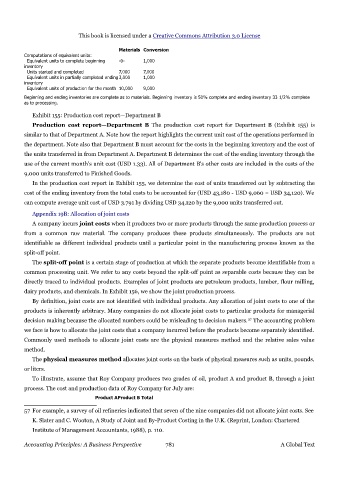Page 780 - Accounting Principles (A Business Perspective)
P. 780
This book is licensed under a Creative Commons Attribution 3.0 License
Materials Conversion
Computations of equivalent units:
Equivalent units to complete beginning -0- 1,000
inventory
Units started and completed 7,000 7,000
Equivalent units in partially completed ending 3,000 1,000
inventory
Equivalent units of production for the month 10,000 9,000
Beginning and ending inventories are complete as to materials. Beginning inventory is 50% complete and ending inventory 33 1/2% complete
as to processing.
Exhibit 155: Production cost report—Department B
Production cost report—Department B The production cost report for Department B (Exhibit 155) is
similar to that of Department A. Note how the report highlights the current unit cost of the operations performed in
the department. Note also that Department B must account for the costs in the beginning inventory and the cost of
the units transferred in from Department A. Department B determines the cost of the ending inventory through the
use of the current month's unit cost (USD 1.33). All of Department B's other costs are included in the costs of the
9,000 units transferred to Finished Goods.
In the production cost report in Exhibit 155, we determine the cost of units transferred out by subtracting the
cost of the ending inventory from the total costs to be accounted for (USD 43,180 - USD 9,060 = USD 34,120). We
can compute average unit cost of USD 3.791 by dividing USD 34,120 by the 9,000 units transferred out.
Appendix 19B: Allocation of joint costs
A company incurs joint costs when it produces two or more products through the same production process or
from a common raw material. The company produces these products simultaneously. The products are not
identifiable as different individual products until a particular point in the manufacturing process known as the
split-off point.
The split-off point is a certain stage of production at which the separate products become identifiable from a
common processing unit. We refer to any costs beyond the split-off point as separable costs because they can be
directly traced to individual products. Examples of joint products are petroleum products, lumber, flour milling,
dairy products, and chemicals. In Exhibit 156, we show the joint production process.
By definition, joint costs are not identified with individual products. Any allocation of joint costs to one of the
products is inherently arbitrary. Many companies do not allocate joint costs to particular products for managerial
decision making because the allocated numbers could be misleading to decision makers. The accounting problem
57
we face is how to allocate the joint costs that a company incurred before the products become separately identified.
Commonly used methods to allocate joint costs are the physical measures method and the relative sales value
method.
The physical measures method allocates joint costs on the basis of physical measures such as units, pounds,
or liters.
To illustrate, assume that Roy Company produces two grades of oil, product A and product B, through a joint
process. The cost and production data of Roy Company for July are:
Product AProduct B Total
57 For example, a survey of oil refineries indicated that seven of the nine companies did not allocate joint costs. See
K. Slater and C. Wooton, A Study of Joint and By-Product Costing in the U.K. (Reprint, London: Chartered
Institute of Management Accountants, 1988), p. 110.
Accounting Principles: A Business Perspective 781 A Global Text

